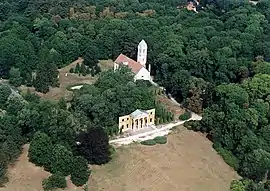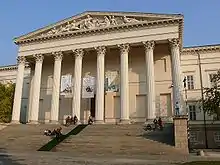Mihály Pollack
Mihály Pollack (born as Michael Pollack, August 30, 1773—January 5, 1855) was an Austrian-born Hungarian architect, key figure of neoclassical architecture. His main work is the Hungarian National Museum (1837–46).
Mihály Pollack | |
|---|---|
.jpg.webp) Portrait of Mihály Pollack from ca.1850, oil on canvas by Mór Than | |
| Born | Michael Pollack 30 August 1773 |
| Died | 5 January 1855 |
| Nationality | Austrian, Hungarian |
| Other names | Mihály Pollák |
| Alma mater | TU Wien, Vienna |
| Occupation | Architect |
| Buildings | Hungarian National Museum, Budapest |
Mihály Pollack was born in Vienna in 1773. Between 1793-94 he moved to Milan to his half-brother architect Leopold Pollack. In 1798 he moved to Pest, where in 1808 he took a lead role in the city's Beautification Commission, and became increasingly influential. Between 1810 and 1830 he designed many residential buildings, later larger palaces and public buildings. His architectural expression progressed from baroque towards neoclassical style.[1] He died, aged 81, in Pest.
 Sándor Palace, Budapest (1803–06)
Sándor Palace, Budapest (1803–06) Ruins of the palace of Archduke Joseph, Alcsútdoboz (1819–27)
Ruins of the palace of Archduke Joseph, Alcsútdoboz (1819–27) Ludovica Military Academy (1828–36)
Ludovica Military Academy (1828–36) Hungarian National Museum (1837–46)
Hungarian National Museum (1837–46)
References
- Pollack Mihály, Hungarian Electronic Library, retrieved 31 October 2012 (in Hungarian)
See also
- Neoclassical architects
- Neoclassical architecture in Hungary
This article is issued from Wikipedia. The text is licensed under Creative Commons - Attribution - Sharealike. Additional terms may apply for the media files.
